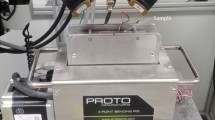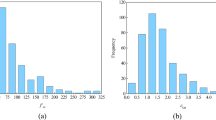Abstract
Concrete is the most common material used in civil infrastructure building. However, concrete deformation such as cracks, abnormalities, or voids can develop at any time during its life cycle or during use. As a result, a tangible assessment is required to determine its strength and quality status. The most prevalent non-destructive approach for assessing the state of concrete structures is the radio frequency (RF) method. However, issues occur when the sample surface is only partially accessible. As a result, this article uses the sensor on the tested concrete to analyse RF as non-destructive testing (NDT). The concrete system is simulated using the COMSOL Multiphysics. The scattering parameters are used to analyse the dielectric characteristics of the sample using the output signal from the sensor. The value for the dielectric constant ranges from 15 to 18. The results are then verified using the Debye model to determine the concrete sample’s dielectric characteristics.










Similar content being viewed by others
References
Abdulhadi B, Kot P, Hashim K, Shaw A, Muradov M, Al-Khaddar R (2021) Continuous-flow electrocoagulation (EC) process for iron removal from water: experimental, statistical and economic study. Sci Total Environ 760:143417. https://doi.org/10.1016/J.SCITOTENV.2020.143417
Abendeh RM, Salman D, Al Louzi R (2022) Experimental and numerical investigations of interfacial bond in self-compacting concrete-filled steel tubes made with waste steel slag aggregates. Dev Built Environ 11:100080
Arunachalam K, Melapudi VR, Udpa L, Udpa SS (2006) Microwave NDT of cement-based materials using far-field reflection coefficients. NDT and E Int 39(7):585–593. https://doi.org/10.1016/j.ndteint.2006.03.001
Azari H, Nazarian S, Yuan D (2014) Assessing sensitivity of impact echo and ultrasonic surface waves methods for nondestructive evaluation of concrete structures. Comput Chem Eng 71:384–391. https://doi.org/10.1016/J.CONBUILDMAT.2014.08.056
Chung KL, Liu R, Li Y, Zhang C (2018) Monitoring of Mix-Proportions of Concrete by Using Microwave Permittivity Measurement. In: 2018 IEEE International Conference on Signal Processing, Communications and Computing, ICSPCC 2018, 1–5. https://doi.org/10.1109/ICSPCC.2018.8567773
Cole KS, Cole RH (1941) Dispersion and absorption in dielectrics. J Chem Phys 9(4):341–351. https://doi.org/10.1063/1.1750906
Costa F, Borgese M, Degiorgi M, Monorchio A (2017) Electromagnetic characterisation of materials by using transmission/reflection (T/R) devices. Electronics 6(4):95. https://doi.org/10.3390/electronics6040095
Dwivedi SK, Vishwakarma M, Soni PA (2018) Advances and researches on non destructive testing: a review. Mater Today Proc 5(2):3690–3698. https://doi.org/10.1016/J.MATPR.2017.11.620
Gholizadeh S (2016) A review of non-destructive testing methods of composite materials. Proc Struct Integr 1:50–57. https://doi.org/10.1016/J.PROSTR.2016.02.008
Gonzalez-Lopez G, Blanch S, Romeu J, Jofre L (2020) Debye frequency-extended waveguide permittivity extraction for high complex permittivity materials: concrete setting process characterization. IEEE Trans Instrum Meas 69(8):5604–5613. https://doi.org/10.1109/TIM.2019.2957895
Hasar UC (2009) Nondestructive and noncontacting testing of hardened mortar specimens using a free-space method. J Mater Civ Eng 21(9):484–493
Ishimaru A (2017) Electromagnetic wave propagation, radiation, and scattering: from fundamentals to applications. John Wiley & Sons
Johnk CTA (1975) Engineering electromagnetic fields and waves. Wiley, New York
Kalyan T, Kishen JC (2013) Experimental evaluation of cracks in concrete by ultrasonic pulse velocity. In: Proceedings of the APCNDT
Kharkovsky SN, Hasar UC, Akay MF, Atis CD (2001) Measurement and monitoring of microwave reflection and transmission properties of cement-based materials for propagation modeling. IEEE Veh Technol Conf 2(53):1202–1206. https://doi.org/10.1109/vetecs.2001.944573
Moore M, Phares BM, Graybeal B, Rolander D, Washer G, Wiss J (2001) Reliability of visual inspection for highway bridges. Turner-Fairbank Highway Research Center
Morita K, Noguchi K (2008) Crack detection methods using radio frequency. 14th World Conf Earthq Eng 24(1):59–66
Morita K, Noguchi K (2006) Crack detection methods using radio frequency identification and electrically conductive materials. AIJ J Technol Des 24:59–66
Nepomuceno MC, Bernardo LF (2019) Evaluation of self-compacting concrete strength with non-destructive tests for concrete structures. Appl Sci 9(23):5109
Neville AM, Brooks JJ (1987) Concrete technology. Longman Scientific & Technical, England
Parkasiewicz B, Kadela M, Bętkowski P, Sienko R, Bednarski Ł (2017) Application of structure monitoring systems to the assessment of the behaviour of bridges in mining areas. In: IOP Conference Series: Materials Science and Engineering, 245(3). IOP Publishing
Perez Gracia V, Canas JA, Pujades LG, Clapes J, Caselles O, Garcı́aOsorio FR (2000) GPR survey to confirm the location of ancient structures under the Valencian Cathedral (Spain). J Appl Geophys 43(2–4):167–174. https://doi.org/10.1016/S0926-9851(99)00056-7
Revilla-Cuesta V, Skaf M, Serrano-López R, Ortega-López V (2021) Models for compressive strength estimation through non-destructive testing of highly self-compacting concrete containing recycled concrete aggregate and slag-based binder. Constr Build Mater 280:122454
Risman P (2016) Terminology and notation of microwave power and electromagnetic energy. J Microw Power Electromagn Energy 26(4):243–250. https://doi.org/10.1080/08327823.1991.11688163
Risman PO, Ohlsson T, Wass B (1987) Principles and models of power density distribution in microwave oven loads. J Microw Power Electromagn Energy 22(4):193–198. https://doi.org/10.1080/08327823.1987.11688023
Ryu GS, Choi S, Koh KT, Ahn GH, Kim HY, You YJ (2020) A Study on initial setting and modulus of elasticity of AAM mortar mixed with CSA expansive additive using ultrasonic pulse velocity. Materials 13(19):1–13. https://doi.org/10.3390/MA13194432
Tan AEC, Jhamb K, Rambabu K (2012) Design of transverse electromagnetic horn for concrete penetrating ultrawideband radar. IEEE Trans Antennas Propag 60(4):1736–1743. https://doi.org/10.1109/TAP.2012.2186242
Testing of concrete Cores for strength–sampling and procedure, 2017
Udpa VR (2017) Nondestructive test methods for evaluation of concrete. NDT and E Int 31(7):585–589
Wang Y, Hu S, Sun X (2022) Experimental investigation on the elastic modulus and fracture properties of basalt fiber–reinforced fly ash geopolymer concrete. Constr Build Mater 338:127570
Yunus MAM, Mukhopadhyay SC (2011) Novel planar electromagnetic sensors for detection of nitrates and contamination in natural water sources. IEEE Sens J 11(6):1440–1447. https://doi.org/10.1109/JSEN.2010.2091953
Acknowledgements
This work is supported under project “Evolutionary analyses of sculptures in cultural heritage by non-destructive microwave spectroscopy” funded by the Department of Science and Technology (DST), Government of India, under Grant DST/TDT/SHRI-38/2018 (G).
Author information
Authors and Affiliations
Corresponding author
Ethics declarations
Conflict of interest
The authors declare that we do not have known competing interests or personal relationships that could have appeared to influence the work of the paper. We have read the final version of the manuscript and are responsible for what is written in it.
Rights and permissions
Springer Nature or its licensor (e.g. a society or other partner) holds exclusive rights to this article under a publishing agreement with the author(s) or other rightsholder(s); author self-archiving of the accepted manuscript version of this article is solely governed by the terms of such publishing agreement and applicable law.
About this article
Cite this article
Dhingra, N., Saluja, N., Garg, R. et al. Radio Frequency as a Non-Destructive Approach to Concrete Structure Health Monitoring. Iran J Sci Technol Trans Civ Eng 47, 2581–2589 (2023). https://doi.org/10.1007/s40996-023-01056-3
Received:
Accepted:
Published:
Issue Date:
DOI: https://doi.org/10.1007/s40996-023-01056-3




